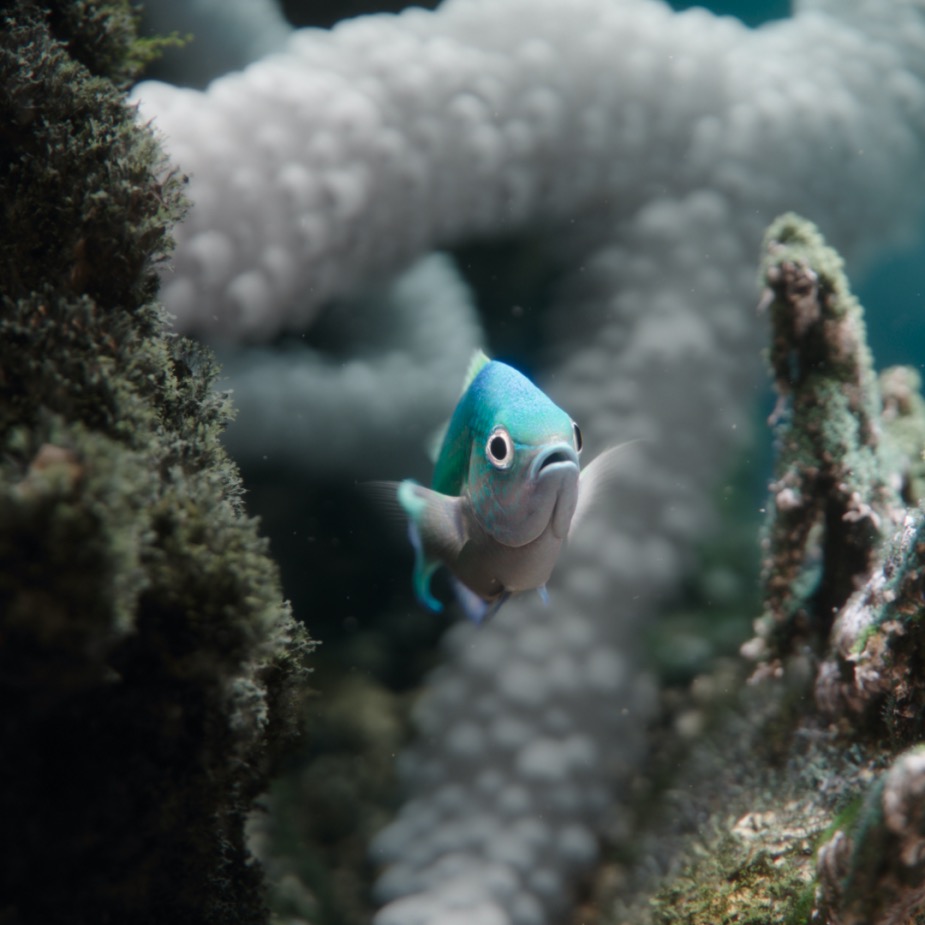
Hope Grows: The Underwater Visual Wizardry Behind SHEBA’s Hope Reef

When Mars-owned pet care brand SHEBA and their agency AMV BBDO were looking to share their ambitious project to help regrow 185,000 square metres of coral reef in the shape of the word ‘hope’ – one of the largest coral regrowth projects in the world – they faced a couple of challenges.
First of all, growing coral takes years, not months. Showing this gigantic reef in its final form was always going to defy the normal commercial production deadline, and so the VFX wizards at Framestore were brought on board early to help visualise the Hope Reef as it will be five years in the future. The second challenge came in the form of a tiny thing called the Covid-19 pandemic. The original vision for the commercial was a live action documentary-style shoot of the reef as it currently is – in its initial regrowth stage, starting to develop – with some end shots enhanced and built-up using CG. When the pandemic locked down the live action shoot, director Murray Butler came on board to help build a whole underwater story from scratch.
From the off, they knew that this would be an ambitious undertaking – three complex 3D environments created based on footage taken of the reef itself. The goal was to keep the VFX as ‘invisible’ as possible, to keep audiences focused on the story and message - so a high level of skill was required to keep things real and restrain the urge to create a flashy CG fiesta.
Every photoreal CG adventure requires a heap of research and an obsession with the minutiae of physics and biology, but with Hope Reef the Framestore team had access to marine biologist Professor Dave Smith, who has been working with SHEBA on the project.
For VFX supervisor Grant Walker it was an unparalleled experience. “No matter what we’re doing, we spend ages researching and learning – not just watching things to observe them visually but learning about the subject that we’re trying to create because we want to understand any little details, you always know ‘why’. We’re inquisitive artists generally. So we always do that anyway but on this occasion having a scientist there, there was always going to be a bit of trepidation. But it was pretty good, he was very particular about the scientific parts – what couldn’t happen – and he helped us understand what corals to put in this ocean. When you’re trying to recreate a place that exists you can’t just pick a pretty-looking coral and stick it in.”
The team didn’t just have to build digital coral, they had to grow it. This strange, fractal lifeform grows in a very distinct way, splitting off at the tips – and Grant and his team were able to devise algorithms and procedural generation techniques in Houdini to ‘grow’ the coral. The idea of creating a time lapse of coral growth – that would be nigh impossible to create for real – was built into Framestore’s original pitch.
“Traditionally, if you go back a few years, when we did underwater projects involving coral, you’d make them by hand. It would take ages to make one coral and then you’d have another 400 to go… technology has moved on, but so has artists’ ability to tackle these challenges in new ways. Our team uses a software called Houdini that allows you to build in a way that you just wouldn’t have been able to do 10 years ago,” says Grant. “At the pitching stage, we said, wouldn’t you want to see the coral grow? It’s not something that you can see easily – there some time lapse footage out there but you’ve got soft coral and the waves are in the way. We put it in the pitch as we thought it was a great opportunity to do something that hadn’t been done before in a commercial.”
What excites Grant and Murray about this project is that it shows the power of VFX, to educate people about the wonders of the natural world by showing them things that are impossible to capture. “It’s the best use of CG because you can’t capture it on camera, and it’s something you can’t see in nature… even though it is nature.”
As well as drawing from the technical expertise of Professor Dave, the Framestore team was also able to draw from the creative sensibilities of AMV BBDO. Before lockdown, the creative team were able to see the coral reef for themselves and had strong ideas about what a coral reef graveyard really looks like, and the emotional experience witnessing that death.
“We had quality discussions about the opening sequence, how dead that should feel and what that deadness should feel like. That was something they pushed and dug their heels in a little bit and that was a really good creative decision. They made it brighter and almost more like a desert scene where we were making it moody and mouldy and black quite early on,” says Murray. Meanwhile, when the job got underway, they say that there was a deep sense of trust between the agency and Framestore.

The desire to create something that was accurate and grounded in reality also challenged Murray in terms of storytelling. He had to build something that would capture the emotion of a very real problem and would suck the viewer in without veering into schmaltz. Murray’s big notes were to avoid splashing into Finding Nemo territory – and as the hope builds throughout the spot and more marine species are introduced, Murray and the team found they had to pull back from what he jokingly refers to as a theatrical ‘fish Mega Mix’. Thankfully, use of pre-visualisation and animation development allowed the team to get that tone and narrative structure right.
The key was to follow a Chromis fish into the reef – borrowing a device from nature documentaries. “If you watch something like Blue Planet, you realise that they’re doing something similar. Of course, they use music, and they have this voice over, but they will create a little story and they’ll focus on a certain fish, and they’ll give that fish a character, even though it potentially doesn’t quite happen like that in real life. They’ll assemble the music, and even though it’s based on reality, they’re weaving dramatic tales. That was our starting point – if they can do this in a documentary and our cue is to make it feel like a documentary in terms of the storytelling, that allowed us to build a narrative around the Chromis. The Chromis isn’t Nemo and we wanted to keep it on the right side of that taste line,” explains Murray.
However, despite the similarities with nature documentaries, when it came to colour the team had rather less leeway than someone working in natural history. With shows like Blue Planet, it turns out that raw footage comes out looking a murky blue, with red channels cancelled out entirely – and the colourists worked hard to push the colour and create something vibrant and magical. But colourist Steffan Perry had to exercise more restraint in the interests of keeping the CG looking real.
“What you see in Blue Planet has a beautiful grade that reveals all the colour, but it tends to look a bit less real… but Blue Planet can do what it wants because it is real already. You can’t make it look CG… but you can easily make CG look not that real. If we revealed all the colour, it wouldn’t look real, so there was always that balancing act,” explains Murray.

The film has been created primarily for 16:9 formats like YouTube, but there's an extra bit of magic to be found in square and portrait formats for other social platforms. From the beginning, the team built those other formats into the production, but when it came time to see what the films would look like in different aspect ratios they were met by a delightful surprise. Suddenly, they could see the surface of the water and upclose fronds of coral, which created an enchanting light effect and what Murray calls an 'almost IMAX experience'.
Speaking to Grant and Murray, it’s clear that, as projects go this has been a particularly meaningful campaign to work on. The gravity of the story, the scale of SHEBA’s ambition married with the technical and creative challenges that have pushed teams to innovate have made it especially enriching. And, let’s not forget, this underwater world was brought to life with teams working remotely across the world, with a client based in Oklahoma, a director in New York and the VFX team and agency in London. For now, Hope Reef is already starting to regenerate and in a few years’ time it will serve as a message to the world as well as a home for thousands of underwater creatures – but for now audiences can take heart and find hope in the visualisations created by Framestore.













